Excavating a Roman villa on Mallorca: A day in the field
Monday, July 24th, Son Servera, Mallorca. It’s very warm, the start of the second week of our project, Vil-la Son Sard, and work is well underway. Despite our ambitious goal of 4 trial trenches, only 3 ended up being excavated.
The history of the Roman baths
That is not to say we had nothing to work on: our supervisors made sure we had plenty to do every day. It is important to highlight that this was a new project. The reason for the project? About 60m from our survey site, in 2012 Roman baths were discovered during the expansion of a road and the addition of a bike lane. As in many countries, Spain requires an archaeologist present to consult in the building of public works and of course check for potential features or finds. That's when the baths were discovered, and after extensive work these were brought to light by a team of local archaeologists. The baths seemed compact and the right size for a private accommodation, and thus we believe that there might be more structures lying nearby, and the theory that the baths might have been a part of a housing complex, possibly even a villa, was formulated.
The fieldwork leads, Ritchie Kolvers from Leiden University, and local archeologist Antoni Puig Palerm started this project, with hopes to discover further parts and structures near to where the baths existed. Alongside Letty ten Harkel, preliminary investigations on the island took place in July 2023.
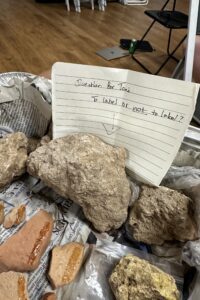
A focus on the three trial trenches
As this project focused on trial trenches, we did not have very large plots that were being excavated, but that allowed us to reach depths of up to 1m on average. While this doesn’t sound very impressive, at one of the trial trenches bedrock was discovered at a depth of under 30cm. Thus many of the trenches are more find-concentrated near the top, something further accentuated by agriculture as plowing and the dumping of constructions conducted nearby mixed the finds and layers in the ground. Thus, we had three trenches, each 1m x 1m, distributed across the plot made available to us by the landowner.
Our analysis of sherds and bones
The week before, I had started on trench 5, and we were focused on remembering and practicing our field-school training in Oss. Namely, how to identify stratigraphic layers and clean up properly in order to take photographs. Due to the rocky texture of the soil, a pickaxe was necessary to dig through each layer, and we always had to keep an eye on finds or soil changes. Our supervisor there, Manos Papaioannou, taught us how to use each side of the pickaxe to make a flat surface and also utilize the tool to excavate big pieces of the soil (and save up on time when necessary). There were 10 layers there, and every day we had to sieve everything through both fine and coarser meshes (both 0.5mm and 1cm) to check for finds.
There were a lot of sherds, from modern all the way to the Roman period which were relevant to our hypothesis at confirming Roman presence. At the end of week 1 was also when a child’s grave was discovered, dug inside the bedrock material at a relatively shallow depth, in trench 6. This was fascinating to me, as a first year student, because it was the first grave I ever saw being excavated. When living in this modern time and surrounded by museums, it is really difficult to put into perspective how close to you all these people are: literally under our feet. It is often unlikely to encounter an excavated grave as a non-archeologist, and before my studies I was never a part of an excavation, making it fascinating for me to see all the remains usually seen in museum exhibitions, in real life. Although preservation was sub-optimal, some teeth and bone fragments were excavated in this tomb, and those will be sent for analysis to determine the age of the individual as well as the date of the burial (and possibly also information on diet or health).
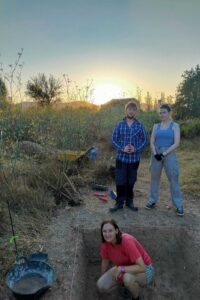
Sieving and processing
And thus we arrive on Monday the 24th. I was transferred to a new trench, under a new supervisor, Vera van Heel. All of the students were moved around trenches, to experience as much of the excavation as possible and collaborate with everyone. In this trench, we were further away from the rest of the group, and as work later during the week unveiled, it was not find-rich, giving us information on where the villa did not extend. The measurements of the trial trenches had already been determined, and we focused on starting to make the trench deeper, all the while sieving for finds. Not much was uncovered; however, we kept digging through, eventually straighten the trench walls and clean up our walls using smaller pickaxes.
As work had started at 6.30am, by 12.30pm we started packing up and heading for lunch and rest from the heat and humidity. In the evenings there was work to be done at the local music school to clean the finds, and begin processing. There was also digital processing, by renaming and organizing the pictures taken on site and by drone, under the careful supervision of Maxime Mulders. Everyone was assigned to different stations, although my personal favorites were digital processing and organizing the photographs, as well as the sorting and drawing of pottery sherds. After everything was cleaned, many of us would sort them into diagnostic and non-diagnostic, and label the ones that could be stored in the depot. The more decorated sherds were also drawn (initially on thin tracing paper) and later digitized.
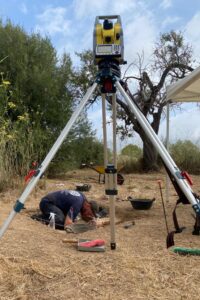
Dinner and discussions with the team
The day would end with dinner, and both meals of the day were taken with the whole group, allowing for discussion of what was found in each different trench. The team was able to stay really closely knit, and all of us enjoyed hanging out and chatting, especially joking about each other and filming funny stories. If you were to ask me, this is the truly important part of each excavation, to know that you’re out there on the field with everyone: archaeology for me is truly not an individualistic field.
For more information and updates, you can follow the Vil-la Son Sard project on Facebook and Instagram!


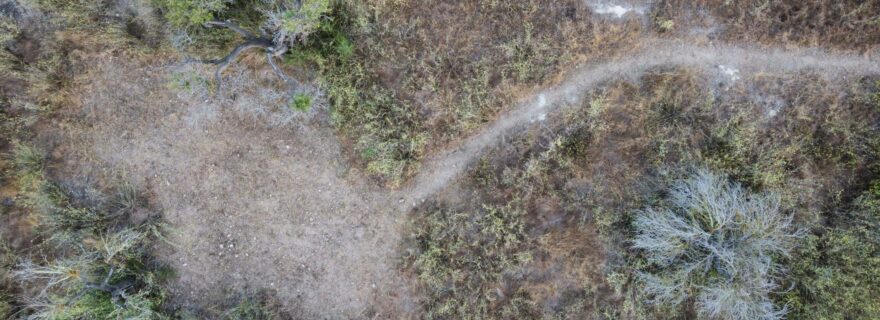


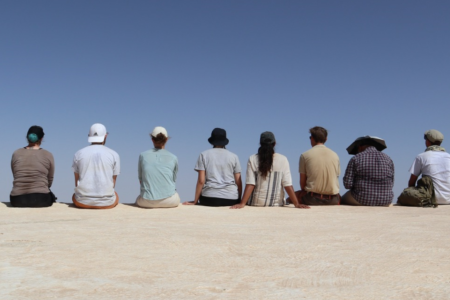
0 Comments